Camera Module Market Size
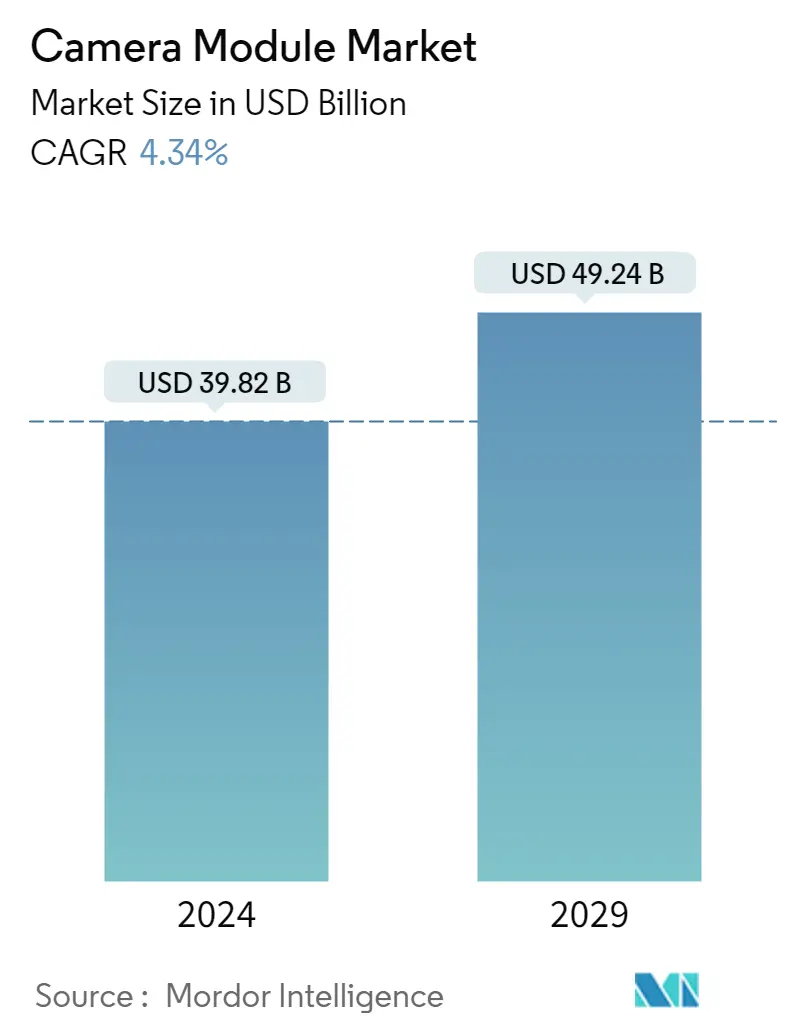
| Study Period | 2019 - 2029 |
| Market Size (2024) | USD 39.82 Billion |
| Market Size (2029) | USD 49.24 Billion |
| CAGR (2024 - 2029) | 4.34 % |
| Fastest Growing Market | Asia Pacific |
| Largest Market | Asia Pacific |
Major Players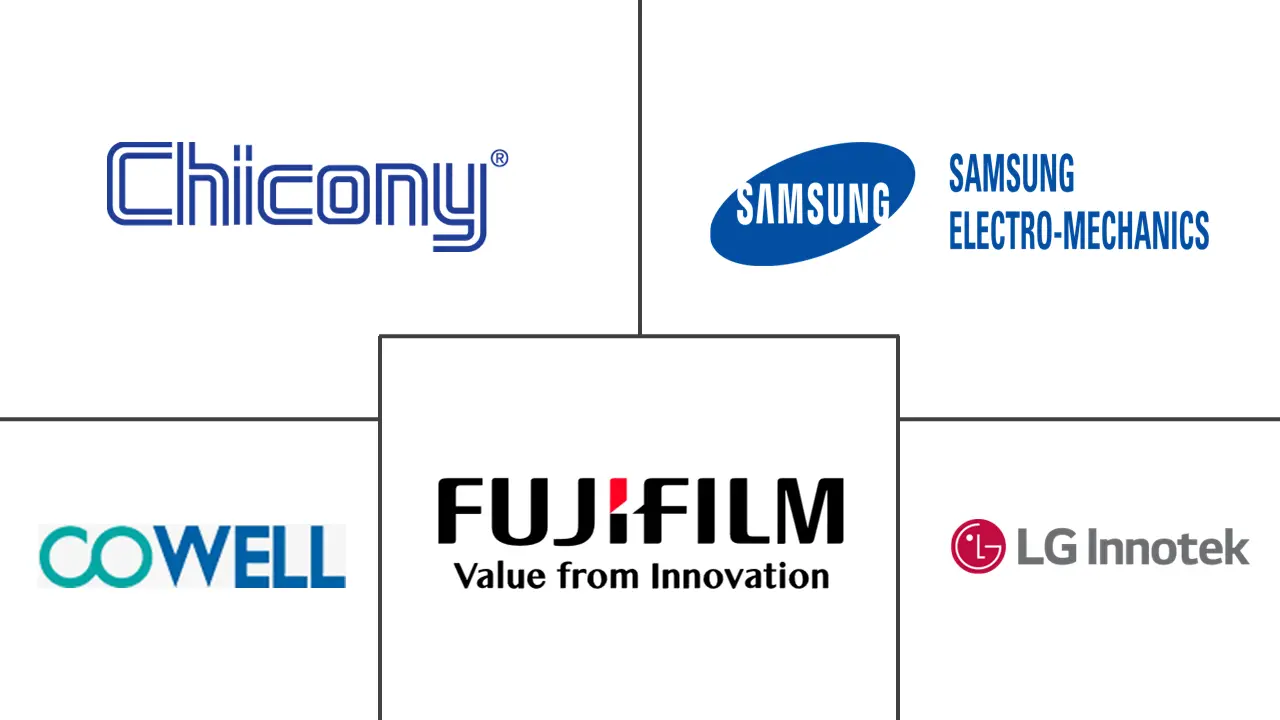
*Disclaimer: Major Players sorted in no particular order |
Camera Module Market Analysis
The Camera Module Market size is estimated at USD 39.82 billion in 2024, and is expected to reach USD 49.24 billion by 2029, growing at a CAGR of 4.34% during the forecast period (2024-2029).
Camera Module Market: A Comprehensive Analysis
- Surge in Advanced Driver Assistance Systems: The camera module market is experiencing significant growth, primarily due to the rising demand for Advanced Driver Assistance Systems (ADAS) in vehicles. Forward camera systems play a crucial role in ADAS by providing advanced sensing capabilities for safety features like lane-keeping assistance, automatic emergency braking, and adaptive cruise control. The increasing reliance on ADAS is prompting industry players to invest heavily in research and development (R&D) and collaborations. For example, Xilinx Inc. and Motovis collaborated to integrate the Xilinx Automotive Zynq system-on-chip platform with Motovis' convolutional neural network IP for vehicle perception and control through forward camera systems.
- Sunny Optical Technology and Valens Semiconductor partnered to incorporate MIPI A-PHY-compliant chipsets into next-generation camera modules for ADAS applications.
- Magna International launched surround-view cameras and electronic control units, making 3D surround-view technology more accessible to consumers.
- Foresight Autonomous Holdings signed a joint proof of concept with a Japanese Tier One supplier to enhance ADAS performance.
- Rising Security Camera Adoption: The growing use of security cameras in both residential and commercial settings is another major factor driving the camera module market. This demand is fueled by the increasing threat of crime and terrorism, coupled with the adoption of IoT-based security systems. For example, the number of installed surveillance cameras in the U.S. surged by 21%, from 70 million in 2018 to 85 million in 2021. Similarly, security system services in the U.K. are projected to generate USD 1,598.84 million in revenue by 2024, up from USD 1,351.9 million in 2019.
- South Korea saw a 200% increase in public CCTV installations, reaching 1,458,465 cameras in 2021.
- Gurugram Metropolitan Development Authority plans to install 1,000 surveillance cameras across 200 locations as part of its smart city initiative.
- Montreal police installed nine additional security cameras in response to rising violent crime rates.
- Technological Advancements Driving Innovation: The camera module market is experiencing rapid technological advancements, especially in mobile photography. Periscope modules have become standard features in flagship smartphones, with manufacturers like O-Film unveiling ultra-thin periscope lens modules. Additionally, Wafer Level Glass (WLG) + Plastic lenses are gaining traction, as seen in Xiaomi’s Redmi K40 Gaming Edition, which incorporates a hybrid WLG camera lens.
- Oppo launched a continuous optical zoom lens offering superior image quality over conventional telephoto sensors.
- Apple was granted a patent for a periscope camera system using prisms, a lens array, and an image sensor.
- Vision Components introduced new MIPI camera modules for medical technology applications, featuring high image resolutions and fast frame rates.
- Market Opportunities and Future Growth: The compact camera module market is on the verge of substantial growth, driven by advancements across applications like smartphones, automotive, and healthcare. The global smartphone market is expanding, with worldwide smartphone subscriptions expected to grow from 6,259 billion in 2021 to 7,690 billion by 2027, according to Ericsson. The automotive sector also presents significant opportunities, particularly with the rising adoption of rear cameras and ADAS forward cameras.
- The average number of cameras per car is increasing, driven by the demand for 360-degree views, cabin monitoring, and e-mirror applications.
- OmniVision and Valens Semiconductor collaborated to develop a MIPI A-PHY-compliant camera solution for automotive applications.
- The healthcare industry is also benefiting, with OmniVision launching its smallest medical CMOS image sensor for endoscopy procedures.
Camera Module Market Trends
Image Sensor Segment Dominating the Component Landscape
- Segment Overview: The image sensor segment commands a significant portion of the camera module market, contributing to 50.16% of the total market revenue in 2021. As the largest component segment, image sensors play a vital role in camera modules across various industries.
- Market Size and Growth: By 2027, the image sensor segment is projected to reach USD 30.08 billion, with a compound annual growth rate (CAGR) of 6.71% from 2022 to 2027. This growth reflects the continued importance of image sensors in the camera module ecosystem.
- Technological Advancements: The demand for higher resolution and better low-light performance is driving technological evolution in image sensors. Canon’s development of a single-photon avalanche diode (SPAD) sensor exemplifies this, allowing high-quality image capture in low-light conditions.
- Competitive Landscape: Intense competition among key players like Sony Group Corporation drives continuous innovation. Sony remains a market leader through strategic partnerships and the development of advanced sensors for smartphones, automotive, and emerging technologies.
- Industry Applications: The adoption of image sensors is expanding beyond traditional camera uses, particularly in the automotive sector, where ADAS and autonomous vehicles require high-quality sensors. OmniVision and Valens Semiconductor collaborated to develop automotive-grade camera solutions, illustrating the automotive sector's growing significance.
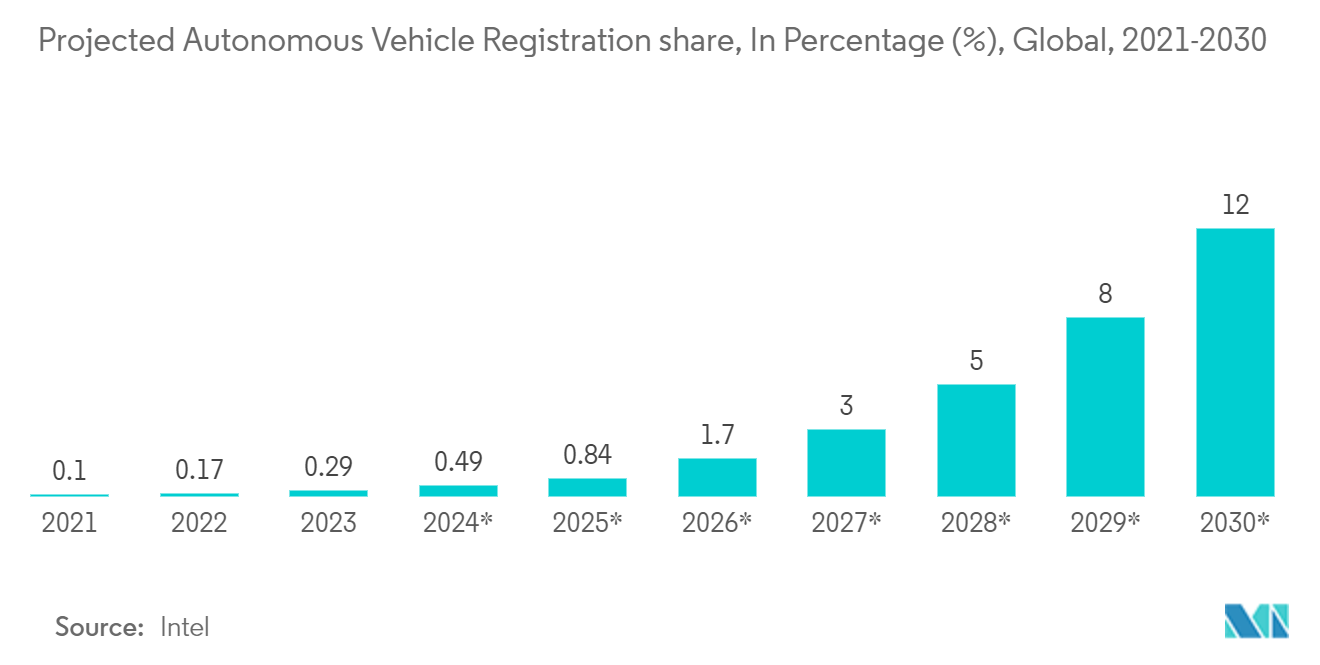
Asia-Pacific The Epicenter of Camera Module Market Growth
- Regional Dominance: The Asia-Pacific region is the fastest-growing and largest segment of the camera module market, expected to reach USD 38.94 billion by 2027 with a CAGR of 10.77%.
Market Drivers:
- Manufacturing Hub: The region's electronics and semiconductor manufacturing capabilities, particularly in China, South Korea, and Taiwan, drive camera module production.
- Smartphone Penetration: Rapid smartphone adoption in populous countries like India and China is fueling demand for camera modules, with China reporting over 1 billion mobile internet users in 2021.
- Automotive Sector Growth: The growing automotive markets in countries like Japan, South Korea, and China are accelerating demand for ADAS and camera modules.
- Government Initiatives: Supportive policies like India's "Make in India" initiative are attracting investments in camera module manufacturing.
- Industry Developments: Key players are investing heavily in the region. Samsung shifted its factory from China to India, aligning with the country's manufacturing goals, while OPPO established a plant capable of producing one smartphone every three seconds.
- Technological Innovation: Asia-Pacific companies like OFILM Group Co. Ltd are at the forefront of innovation, establishing research institutes to maintain a competitive edge in the global market.
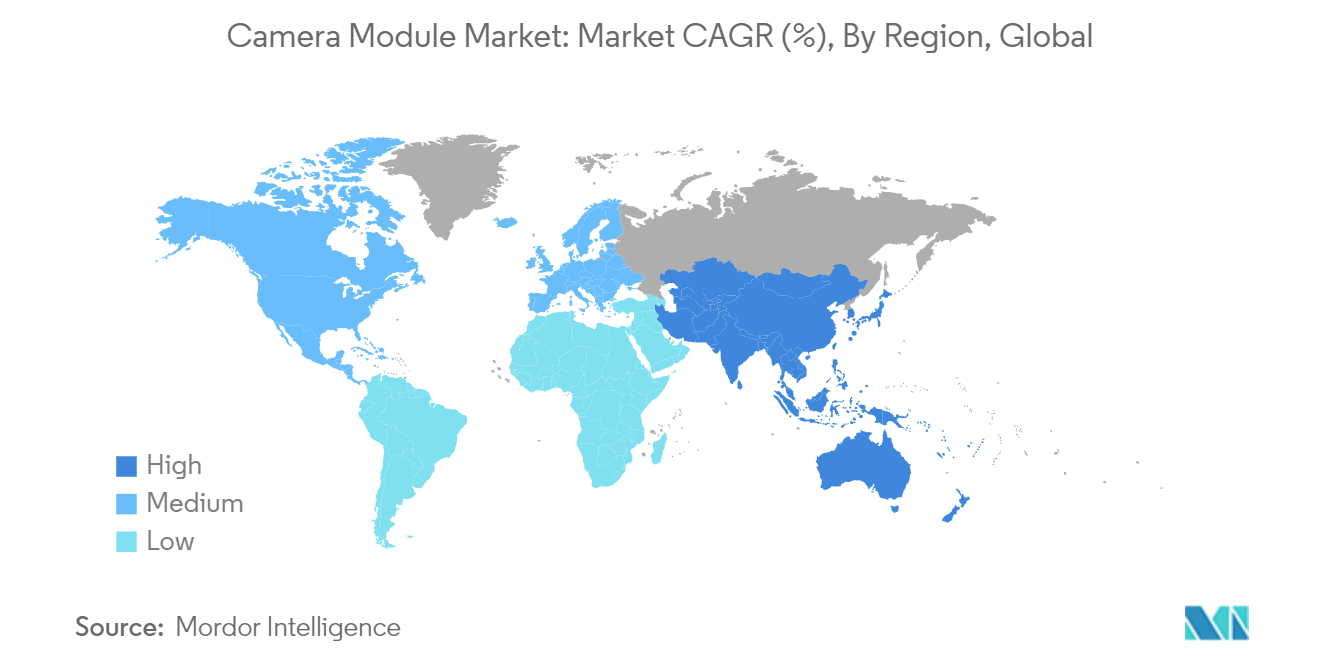
Camera Module Industry Overview
The camera module market is highly consolidated, with leading global players such as LG Innotek, Sunny Optical, and O-Film commanding a 75% market share in 2021. Smaller players like Luxvisions, Chicony, and Mcnex collectively account for 34.6% of the remaining market share.
Innovation and Vertical Integration: Market leaders emphasize R&D and vertical integration. For instance, LG Innotek invests over 5% of its annual revenue in R&D and plans to increase production capacity with a USD 1.07 billion investment. Sunny Optical has bolstered its vertical integration by acquiring Fuji Tianjin and establishing its own precision optics company.
Strategies for Future Success: Companies must invest in technological advancements, strategic partnerships, and market diversification to remain competitive. Sunny Optical’s partnership with Valens Semiconductor to develop ADAS-compliant camera modules exemplifies this. Moreover, companies should focus on emerging sectors like automotive and IoT, while optimizing manufacturing processes to meet growing demand for miniaturized, high-performance camera modules.
Camera Module Market Leaders
-
Chicony Electronics Co. Ltd
-
Cowell E Holdings Inc.
-
Fujifilm Corporation
-
LG Innotek Co. Ltd
-
Samsung Electro-Mechanics Co. Ltd.
*Disclaimer: Major Players sorted in no particular order
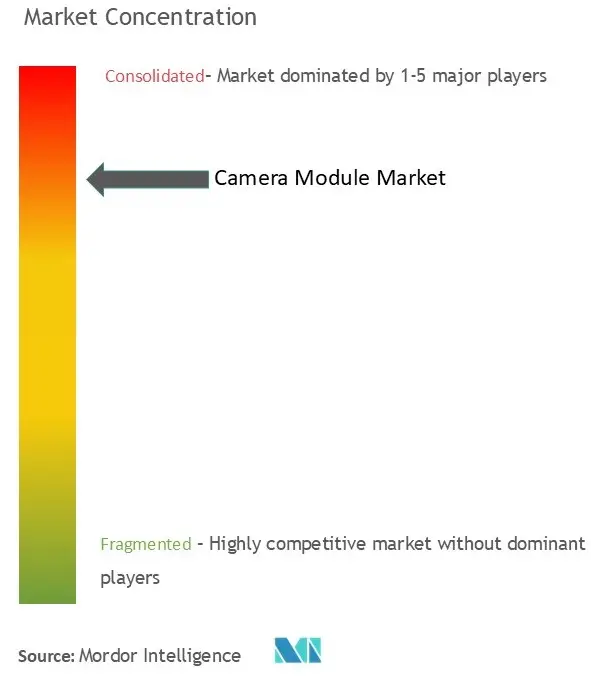
Camera Module Market News
- September 2024 - Primax Electronics introduced a new camera module called HOC miniature camera module. The camera module uses laser cutting techniques and multifunctional adhesives to achieve reduced dimensions.
- July 2024 - LG Innotek invested in its Vietnam facility to expand camera module production. The expansion would increase camera module production capacity and add production of transmission items for camera modules and 3D sensor modules.
- July 2024 - Apple tested Samsung sensors for camera modules in iPhone 16 series, indicating a potential shift from Apple's exclusive use of Sony camera modules in iPhones.
Camera Module Market Report - Table of Contents
1. INTRODUCTION
- 1.1 Study Assumptions and Market Definition
- 1.2 Scope of the Study
2. RESEARCH METHODOLOGY
3. EXECUTIVE SUMMARY
4. MARKET INSIGHTS
- 4.1 Market Overview
-
4.2 Industry Attractiveness - Porter's Five Forces Analysis
- 4.2.1 Bargaining Power of Suppliers
- 4.2.2 Bargaining Power of Buyers
- 4.2.3 Threat of New Entrants
- 4.2.4 Threat of Substitute Products
- 4.2.5 Intensity of Competitive Rivalry
- 4.3 Industry Value Chain Analysis
- 4.4 Assessment of Impact of COVID-19 on the Industry
- 4.5 Price Trend Analysis
-
4.6 Ultra Small Camera Module Dynamics
- 4.6.1 Evolution of Camera Module Size Across Various Applications
- 4.6.2 Product Mapping with Resolutions Offered by Various Vendors
- 4.6.3 Resolution Vs. Cost Analysis
5. MARKET DYNAMICS
-
5.1 Market Drivers
- 5.1.1 Increased Market Demand for Advanced Driver Assistance Systems in Vehicles
- 5.1.2 Increased Use of Security Cameras in Households and Commercial Establishments
-
5.2 Market Restraints
- 5.2.1 Complicated Manufacturing and Supply Chain Challenges
-
5.3 Technology Evolution Trends
- 5.3.1 Component-wise Technological Advancements
- 5.3.2 Average Number of Cameras Per End-product - Smartphones Vs. Light Vehicles / Camera Evolution in a Mobile Phone
6. MARKET SEGMENTATION
-
6.1 By Component
- 6.1.1 Image Sensor
- 6.1.2 Lens
- 6.1.3 Camera Module Assembly
- 6.1.4 VCM Suppliers (AF & OIS)
-
6.2 By Application
- 6.2.1 Mobile
- 6.2.2 Consumer Electronics (Excl. Mobile)
- 6.2.3 Automotive
- 6.2.4 Healthcare
- 6.2.5 Security
- 6.2.6 Industrial
-
6.3 By Geography***
- 6.3.1 North America
- 6.3.2 Europe
- 6.3.3 Asia
- 6.3.4 Australia and New Zealand
- 6.3.5 Latin America
- 6.3.6 Middle East and Africa
7. VENDOR MARKET SHARE ANALYSIS
- 7.1 Camera Module Vendor Market Share
- 7.2 Image Sensor (CIS) Vendor Ranking
- 7.3 Lens Set Vendor Ranking
8. COMPETITIVE LANDSCAPE
-
8.1 Company Profiles*
- 8.1.1 Chicony Electronics Co. Ltd
- 8.1.2 Cowell E Holdings Inc.
- 8.1.3 Fujifilm Corporation
- 8.1.4 LG Innotek Co. Ltd
- 8.1.5 Samsung Electro-Mechanics Co. Ltd
- 8.1.6 Primax Electronics Ltd
- 8.1.7 LuxVisions Innovation Limited (Lite-On Technology Corporation)
- 8.1.8 Sharp Corporation
- 8.1.9 Sony Group Corporation
- 8.1.10 STMicroelectronics NV
- 8.1.11 Sunny Optical Technology (Group) Company Limited
- 8.1.12 AMS OSRM AG
- 8.1.13 On Semiconductor (Semiconductor Components Industries LLC)
- 8.1.14 OFILM Group Co. Ltd
- 8.1.15 OmniVision Technologies Inc.
9. INVESTMENT ANALYSIS
10. MARKET OPPORTUNITIES AND FUTURE GROWTH
** Subject To AvailablityCamera Module Industry Segmentation
The camera module, also known as a compact camera module (CCM), is widely used in security systems, video conferencing, real-time monitoring, and other applications as a video input device. Maturity in photographic imaging device technology, continuous improvement in the network's speed, and advancement in internet technology have boosted the camera module market’s development and growth. One of the prime factors triggering the demand for camera modules is their wide adoption in smartphones, automotive, healthcare, and various other applications.
The camera module market is segmented by component (image sensor, lens, camera module assembly, and VCM suppliers (AF & OIS)), by application (mobile, consumer electronics (excluding mobile), automotive, healthcare, security, and industrial), and geography (North America, Europe, Asia Pacific, and Rest of the World). The report offers market forecasts and sizes in volume (units) and value (USD) for all the above segments.
| By Component | Image Sensor |
| Lens | |
| Camera Module Assembly | |
| VCM Suppliers (AF & OIS) | |
| By Application | Mobile |
| Consumer Electronics (Excl. Mobile) | |
| Automotive | |
| Healthcare | |
| Security | |
| Industrial | |
| By Geography*** | North America |
| Europe | |
| Asia | |
| Australia and New Zealand | |
| Latin America | |
| Middle East and Africa |
Camera Module Market Research FAQs
How big is the Camera Module Market?
The Camera Module Market size is expected to reach USD 39.82 billion in 2024 and grow at a CAGR of 4.34% to reach USD 49.24 billion by 2029.
What is the current Camera Module Market size?
In 2024, the Camera Module Market size is expected to reach USD 39.82 billion.
Who are the key players in Camera Module Market?
Chicony Electronics Co. Ltd, Cowell E Holdings Inc., Fujifilm Corporation, LG Innotek Co. Ltd and Samsung Electro-Mechanics Co. Ltd. are the major companies operating in the Camera Module Market.
Which is the fastest growing region in Camera Module Market?
Asia Pacific is estimated to grow at the highest CAGR over the forecast period (2024-2029).
Which region has the biggest share in Camera Module Market?
In 2024, the Asia Pacific accounts for the largest market share in Camera Module Market.
What years does this Camera Module Market cover, and what was the market size in 2023?
In 2023, the Camera Module Market size was estimated at USD 38.09 billion. The report covers the Camera Module Market historical market size for years: 2019, 2020, 2021, 2022 and 2023. The report also forecasts the Camera Module Market size for years: 2024, 2025, 2026, 2027, 2028 and 2029.
What future developments are expected in the Camera Module Market?
Future developments in the Camera Module Market are: a) Miniaturization of modules b) Increased adoption of camera modules in IoT devices c) Advancements in lens technology for better image quality under various conditions
What future developments are expected in the Camera Module Market?
Future developments in the Camera Module Market are: a) Miniaturization of modules b) Increased adoption of camera modules in IoT devices c) Advancements in lens technology for better image quality under various conditions
What future developments are expected in the Camera Module Market?
Future developments in the Camera Module Market are: a) Miniaturization of modules b) Increased adoption of camera modules in IoT devices c) Advancements in lens technology for better image quality under various conditions
Camera Module Industry Report
Camera Module Market Research
Our comprehensive camera module market research report provides in-depth insights into key industry trends, technological advancements, and market dynamics driving growth across various sectors, including automotive, healthcare, and consumer electronics. The report offers detailed analysis covering segmentation by component, application, and region, giving stakeholders a clear understanding of emerging opportunities. By examining partnerships, product innovations, and competitive strategies of leading camera module manufacturers and suppliers, this report equips industry players with actionable data to navigate the evolving landscape. All findings are presented in an easy-to-read report pdf format for efficient decision-making.
This report is an essential resource for manufacturers, investors, and R&D professionals seeking to leverage the latest camera module technology for strategic growth. It highlights advancements such as ADAS integration in vehicles, smartphone camera innovations, and IoT device applications. With industry research that includes market trends, forecast data, and an expert overview of market segmentation, stakeholders can anticipate changes in consumer demand and production capabilities. The report pdf provides critical insights that support strategic planning, investment, and development initiatives in this rapidly advancing market.



